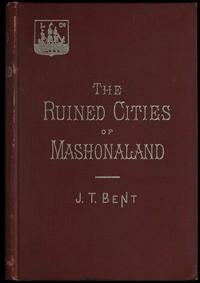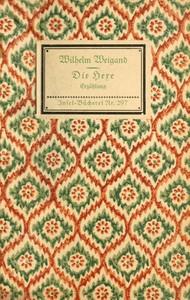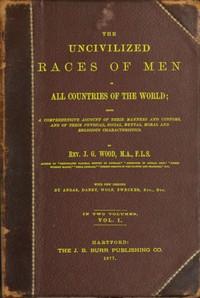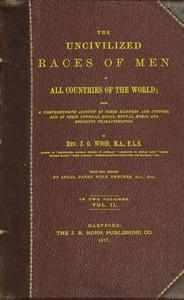|
|
Read this ebook for free! No credit card needed, absolutely nothing to pay.Words: 64896 in 11 pages
This is an ebook sharing website. You can read the uploaded ebooks for free here. No credit cards needed, nothing to pay. If you want to own a digital copy of the ebook, or want to read offline with your favorite ebook-reader, then you can choose to buy and download the ebook.

: The ruined cities of Mashonaland: Being a record of excavation and exploration in 1891 by Bent J Theodore James Theodore Swan R M W Robert McNair Wilson Contributor - Great Zimbabwe (Extinct city); Extinct cities Zimbabwe Mashonaland@FreeBooksThu 08 Jun, 2023 open space protected on two sides by rocks and on two by walls. This space was also full of wall foundations; but, being open to the sun, it had been occupied and ransacked by the Kaffirs. To the south of the temple a flight of steps led down to the gold-smelting furnaces and the caves, of which I shall speak more at length in connection with the finds. This corner of the building was the only one in which our excavations were successful, and I entirely attribute this fact to its chilly and shady position--a spot studiously avoided by the succeeding generations of Kaffir tribes for this reason. Below the temple at the bottom of the precipice we commenced work, with great hope of finding the other portions of the bowls, &c., which we had found above. Here there is an enormous mass of fallen stones from the buildings above, but amongst them we found surprisingly little of interest. Perhaps a thorough excavation of this slope would yield further results, as so many of our finds in the temple above are fragmentary, and the presumption is that the other portions were thrown over the precipice; but this will be a gigantic work, entailing an enormous amount of labour and expenditure. Such is the great fortress of Zimbabwe, the most mysterious and complex structure that it has ever been my fate to look upon. Vainly one tries to realise what it must have been like in the days before ruin fell upon it, with its tortuous and well-guarded approaches, its walls bristling with monoliths and round towers, its temple decorated with tall, weird-looking birds, its huge decorated bowls, and in the innermost recesses its busy gold-producing furnace. What was this life like? Why did the inhabitants so carefully guard themselves against attack? A thousand questions occur to one which one longs in vain to answer. The only parallel sensation that I have had was when viewing the long avenues of menhirs near Carnac, in Brittany, a sensation at once fascinating and vexatious, for one feels the utter hopelessness of knowing all one would wish on the subject. When taken alone this fortress is sufficiently a marvel; but when taken together with the large circular building below, the numerous ruins scattered around, the other ruins of a like nature at a distance, one cannot fail to recognise the vastness and power of this ancient race, their great constructive ingenuity and strategic skill. About eight miles from Zimbabwe, standing alone in a fertile valley, there is another ruin which we visited, presumably of a later and inferior date, for the courses and stones are irregular and correspond to the later constructions at Zimbabwe. It too stands on a flat granite rock, and its structure is equally intricate, as will be seen from the plan. The natives know it by the name of the Little Zimbabwe, but for purposes of investigation into the origin of the constructing race it affords us no special point of value, which is the case also with most of the other ruins which we visited, and nothing need be said about them except to point out their existence. These remarks refer to the ruins which we found at Metemo, Chilondillo, Chiburwe, and in the Mazoe valley, all of which were obviously erected as forts to protect a surrounding population. Some of them are of the best period of workmanship, notably those at Chiburwe and in the Mazoe valley; others are of inferior workmanship, with uneven courses and irregularly shaped blocks of granite, proving that, as we find the two periods side by side at the Great Zimbabwe, also we have them scattered over the country. The great ruin at Matindela is second only in importance to the Great Zimbabwe itself, and merits a close description. The circular building at Matindela encloses an area not far short of that enclosed by the large circular building at the Great Zimbabwe; it crowns a low sloping granite kopje about 150 feet in height. The place is full of huge baobab trees, two of which in their growth have pushed down and grown up in the walls themselves. There are those that tell us about the fabulous age of the baobab, attributing an age of 5,000 years to the larger ones. The Director of Kew Gardens, Mr. Thiselton Dyer, tells me that this is grossly exaggerated, and that a few centuries is probably all that can be attributed to the very largest. Be this as it may, the baobabs have grown up and arrived at maturity long after the building of the Matindela ruins and their subsequent abandonment. The best built portion of the wall has the same aspect as that at the Great Zimbabwe; but the other side, corresponding to the worst built part of the Zimbabwe wall, has never been completed at Matindela; the fact that the south-eastern side has been so strongly built and so much trouble has been spent on its decoration, and that the north side is comparatively open and neglected, and that the hill is equally assailable from both sides, leads one naturally to infer that the idea of a temple is here more prominent than that of a fortress. The walls at Matindela are nowhere more than fifteen feet in height, nor are the courses nearly as regular as those at the Great Zimbabwe; but the great feature of interest is here the arrangement of the patterns, which establish beyond a doubt that they were inserted in the walls for a more complex purpose than mere ornamentation. The arrangement of these patterns is as follows: First to the south-east comes the herring-bone pattern, running over the chief entrance as a lintel for six yards. Here it ends, and two feet below begins the dentelle pattern for the same distance; then the pattern stops altogether on the outside, but there are indications that it was continued on the inside instead. Then it is again inserted for forty feet on the outside, and finally is again put on the inside for the remainder of its extent--namely, thirteen feet. Above the pattern and nearly over the principal entrance a curious loophole is still left standing, and the best portion of the wall has been battlemented, the outside portion being raised in front two or three feet higher than the back. The wall is eleven feet six inches at its thickest, and on the top of it we saw holes in which monoliths evidently once stood, as they did on the wall of the circular building at the Great Zimbabwe. Another very marked feature at Matindela is that the doorways are all square, like those at the Lundi ruin, and not rounded off, as those at Zimbabwe, and then again all these doorways have been walled up in an uniform fashion, the courses corresponding exactly to those of the rest of the wall. In the original construction of the building certain spaces of seven feet had been left in the wall; two feet on either side had then been built up, thus leaving an entrance of three feet, which entrance in its turn had also been walled up. Here, as at the Great Zimbabwe, the theory at once occurred to me that these places had been walled up at a time of siege; but when one takes into consideration the care with which these apertures have been walled up, and the triple nature of the added wall, this theory seems untenable. The walling up of the pylons in certain Egyptian temples at Karnak, which Prof. Norman Lockyer brought before my notice, seems an apt parallel, though the reasons for so doing do not seem to my mind at present sufficiently proved. It must also be borne in mind that the walling up of the principal entrance at Matindela must have taken place prior to the construction of the pattern which rests upon it. The interior of this building, as will be seen from the plan, was divided up into chambers, as the other ruins at Zimbabwe, but the walls here are much straighter, and the circular system of construction seems to have been more or less abandoned. I take it that this ruin at Matindela was constructed by the same race at a period of decadence, when the old methods of building had fallen into desuetude. Outside the walls of the temple or fortress we found many circular foundations, very regularly built of granite blocks, and varying in diameter from six to fifteen feet. They were built in groups at considerable intervals apart, and we counted over forty of them. Some of these circular foundations have a double circle, as if for a step; the probability is that they formed the foundations of stone huts like those found in the Marico district of the Transvaal, and were the homes of the ancient inhabitants under the protecting wing of the temple-fortress. There are no traces of these circular foundations within the walls of the enclosure, but all were found outside within a radius of two hundred yards. There are traces, too, of other buildings about half-way down the slope of the granite hills, two walls parallel to one another, about thirty feet long, with doorways and six circular foundations outside them. There are also two depressions on the eastern side of the hill, now filled up with timber, which were probably the quarries from which the builders obtained the stone for their work. About twelve miles to the north of Matindela, near a mountain called Chiburwe, on another low granite hill, we found another fort with similar circular foundations on the plain around it. This fort is about forty feet in diameter, and the walls are of the best period, with courses far more even than those of Matindela, and the stones of more uniform size and fitting more closely, corresponding to the best of the buildings at the Great Zimbabwe. Here, too, was another gigantic baobab tree, which had grown up in the wall and knocked it down; and here, too, the south-eastern portion of the wall is much better and thicker than the rest, which has in places either never existed or fallen down; but the destruction here was so complete that it was impossible to tell if there ever had been a pattern on it or not. Free books android app tbrJar TBR JAR Read Free books online gutenberg More posts by @FreeBooks

: The isle of dead ships by Marriott Crittenden McKernan Frank Illustrator - Science fiction; Mate selection Fiction; Castaways Fiction; Sargasso Sea Fiction@FreeBooksThu 08 Jun, 2023

: The uncivilized races of men in all countries of the world; vol. 1 of 2 Being a comprehensive account of their manners and customs and of their physical social mental moral and religious characteristics by Wood J G John George - Ethnology; Anthropology; M@FreeBooksThu 08 Jun, 2023
|
Terms of Use Stock Market News! © gutenberg.org.in2025 All Rights reserved.






